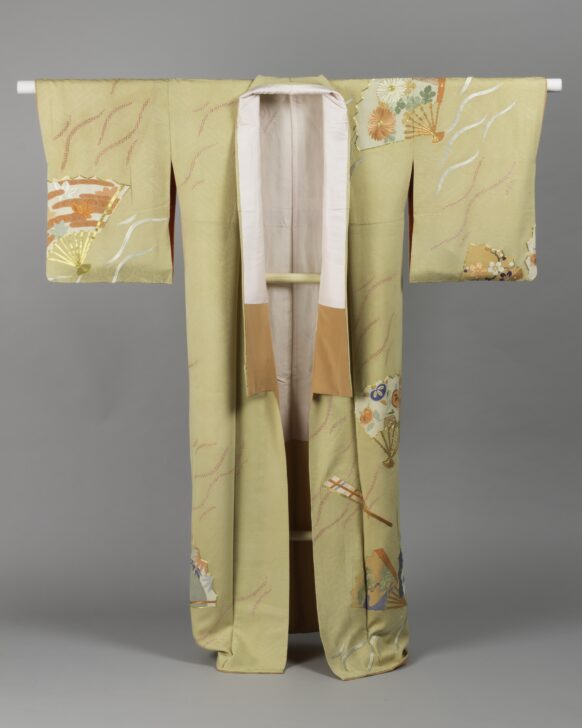Kimono
Japanese

Description
Japan
Showa period (1926–1989)
Mid- to late 20 th century
Silk with painted, stenciled, gilt, and embroidered designs
Gift of Mrs. Kazuko Miyake, 2016/2.72
The design and the technique of this sumptuous kimono are quite sophisticated.
The flowers, plants and cranes refer to seasonal changes and are meant to bring
luck. The open fans are a symbol of everlasting prosperity and happiness.
Beautifully wrought, they appear to float on the water, which is represented by
stylized wave patterns. The rich decoration is achieved through a combination of
intricate techniques, including woven patterns, stencil dyes, hand-painted yūzen
(a resist-dyeing technique), and embroidery of colored and metallic threads.
This kimono is part of a gift of sixty-four traditional Japanese garments donated
to UMMA in 2016 by Kazuko Miyake. She is the younger sister of Shizuko Iwata,
who donated her own and her mother’s collection to the Museum in 2005 and
2013. Their mother, Shizuka Iwata, a pioneering businesswoman in early
twentieth-century Japan, commissioned lavish sets of kimono, obi, and haori for
her five daughters.
Subject Matter:
The oogi (fan) motifs contain dyed and gold embroidered cranes, pine trees, autumnal leaves, chrysanthemums, plum blossoms, kanze (whirlpool), takara zukushi (precious objects) motifs with silver threaded and shibori-dyed wave motifs.
The dyed portions were rendered using tegaki yuzen process.
Yuzen is a stretch-resist dyeing technique invented by Miyazaki Yuzen, a famous Kyoto fan-painter during the Gentoku era (1688-1704). Yuzen has two dyeing styles: “Tegaki Yuzen” hand painting and “Kata Yuzen” stencil dyeing. “Tegaki Yuzen” is the more traditional technique. Its hand-painting skills create beautiful and elaborate designs. “Tegaki Yuzen” is named differently according to the place in which it was produced: Kyo Yuzen (Kyoto), Kaga Yuzen (Ishikawa) and Tokyo Yuzen (Tokyo). They are the three major Yuzen in Japan. Among these, Kyo Yuzen is considered the most gorgeous and elegant.
The inner lining includes eight different parts (hakkake) on the bottom and sleeve edges that gives the inner lining a more colorful appearance. Houmongi is a semi-formal kimono that can be worn by both married and single women for social events. It is called second-class formal wear.
Houmongi is created by a patterning method called “Eba:” the pattern is dyed in such a way that it creates an unbroken design across the seams when the kimono is sewn together.
Physical Description:
gold-beige houmongi kimono with interwoven sayagata (sauvastica, reverse swastika) patterning motifs with dyed and gold-embroidered oogi (fan) motifs with a white and orange cream inner lining.
Usage Rights:
If you are interested in using an image for a publication, please visit https://umma.umich.edu/request-image/ for more information and to fill out the online Image Rights and Reproductions Request Form.